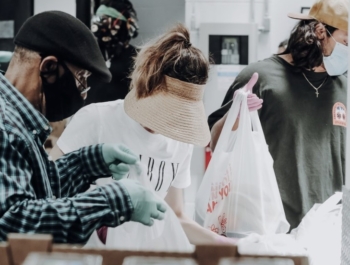
News

These Social Ventures are Scaling Impact by Improving Systems, Not Disrupting Them
Posted in ImpactAlpha on January 18, 2024
By David Blank
To learn more about DRK Foundation, contact kshehade@drkfoundation.org.
Disrupters have long held the edge in Silicon Valley, as well as in the world of social ventures. If some system isn’t delivering, goes the conventional wisdom, just topple it and rebuild a more optimal version.
There’s one problem: The approach doesn’t always work.
One pioneering social investor found that system-disruptors had less impact on social inequities than solutions that tweaked existing structures and improved them.
Leverage the system, don’t disrupt it, now says Jim Bildner, CEO of the Draper Richards Kaplan Foundation, which has funded more than 200 nonprofit and for-profit social enterprises in the US, Europe, Africa and India.
The foundation, the philanthropic arm of venture capital firm Draper Richards, says its portfolio of healthcare, education and criminal justice companies have impacted the lives of over 300 million people. One in five of those companies is improving the lives of over a million people. A study of top-performers revealed a common thread.
“Organizations that relied on disruption were not as successful as the organizations that leveraged the existing infrastructure,” Bildner told ImpactAlpha. “Every single one of them was leveraging what existed on the ground and not blowing it up.”
Within systems
Take Recidiviz. Founded inside Google, the data nonprofit spun out in 2018 to accelerate criminal justice reform by empowering advocates for incarcerated people and their families.
The operating assumption of the company’s founders was that the people inside of criminal justice systems had the data and tools they needed and were failing to use it, intentionally or not. The problem, they thought, was in making that data available to outside advocates working on reform.
“You’re not actually solving the right problem,” Leann Bertsch, then North Dakota director of corrections told the Recidiviz team, according to product manager Serena Chang. “She said, ‘We actually are the ones that need your help.’”
It is the prisons themselves that don’t have the data, and what they do have, they don’t know how to use. Data fragmentation was causing people to stay stuck in the system much longer than they deserved to be with policies already on the books.
“Rules already exist, but the data systems that track this information don’t talk to each other,” Chang said. “We shifted the strategy to work with the corrections agencies themselves to solve their problems.”
Recidiviz’s data platform automatically flags when inmates are eligible for parole, or when parolees are up for discharge. “For people in prison, that means they’re getting unstuck from the system and getting out and getting downgraded sooner.”
Prison systems in 15 states covering roughly 30% of the nation’s prison population now use Recidiviz, which has helped more than 103,000 people accelerate out of incarceration.
“That’s the tool that we’ve built by just talking to the people who are running the system, or in the system, or around the system,” Chang said. “Understanding what their problems are and trying to align on a shared goal.”
Paradigm shift
The finding that leveraging systems can be more impactful than disrupting them was a surprise to Bildner at Draper Richards Kaplan Foundation. As recently as 2016, Bildner, along with New Profit’s Vanessa Kirsch and Jeff Walker, made the opposite case in an article in Harvard Business Review.
Change-makers, they argued, needed to change the entire system. Even if they failed, mature organizations or policymakers would learn from them and adopt these new disruptive models.
Inside the DRK Foundation, the thinking around systems has shifted from “Bad infrastructure is terrible, that’s why it needs to be blown up,” to “Infrastructure isn’t perfect and can be improved,” says Bildner.
That paradigm shift is enormous, he says. From the standpoint of funders, the shift mitigates operating risk.
Take healthcare. Disruption mode means creating a new health system. From design to deployment to the amount of funding required to drive adoption, “It’s enormously complicated,” says Bildner.
Leveraging existing, if imperfect, infrastructure simplifies the solutions. Boswell, a DRK portfolio company, for example, helps healthcare providers engage eligible but hard-to-reach Medicaid beneficiaries where they’re at, like at one of the more than 100,000 food pantries across the country.
In education, Kinvolved (acquired by PowerSchool in 2022), an earlier portfolio company, chose to mitigate absenteeism, rather than disrupt public education. Its app helped boost attendance and decrease chronic absenteeism for hundreds of thousands of students by improving communication between teachers and parents about students who don’t show up for class.
The infrastructure exists, says Bildner. “So fill the gaps, modify the system, and achieve mission.”
Infrastructure first
Some social innovators, including Acumen’s Jacqueline Novogratz, have long warned of the dangers of becoming too enamored of disruption.
“I’ve never felt more excited by what is possible,” Novogratz clarified on the sidelines after her keynote at the Skoll World Forum – in 2013. “I simply wanted to voice the reality that disruption and going against the status quo is not for the faint of heart!”
“Disruption is often necessary, yes, but instead of being confrontational, the disruption can be organized from within and can be much more effective and sustainable,” Molly Melching, an activist against female genital cutting in Africa, shared at the same Skoll Forum. “Once a critical mass is achieved, then we can have a new social norm.”
Working within systems can offer pathways to scale. The internal combustion engine supply chain, for example, is one of the largest in the world and employs tens of millions of people. Wave Equity Partners, a growth-stage cleantech investor, last year invested in a company that has modified a diesel engine to run on fuel that is 70% water and 30% ethanol. The engine might even have a lower carbon footprint than an electric vehicle.
“The supply chains, the value chains of transportation, energy and water are so massive and so extensive on the planet that you don’t want to disrupt them,” Wave Equity’s Praveen Sahay told ImpactAlpha. “You want to help them transition to a greener pathway.”
Back to criminal justice reform. Hundreds of millions of dollars spent on change have been wiped out as views on reform shift from one administration to the next. Proving out lower costs and better outcomes from improvements to existing social infrastructure may serve as one antidote to such political dysfunction.
“The world is so polarized that consensus to get anything done from the top is impossible,” says Bildner. “When you use ‘leverage first,’ and over time build your impact into the hundreds of thousands of people, it doesn’t really matter what the political condition is, it’s so resilient.”
“That’s why we’re such a strong believer in infrastructure-first, leverage-first models.”
